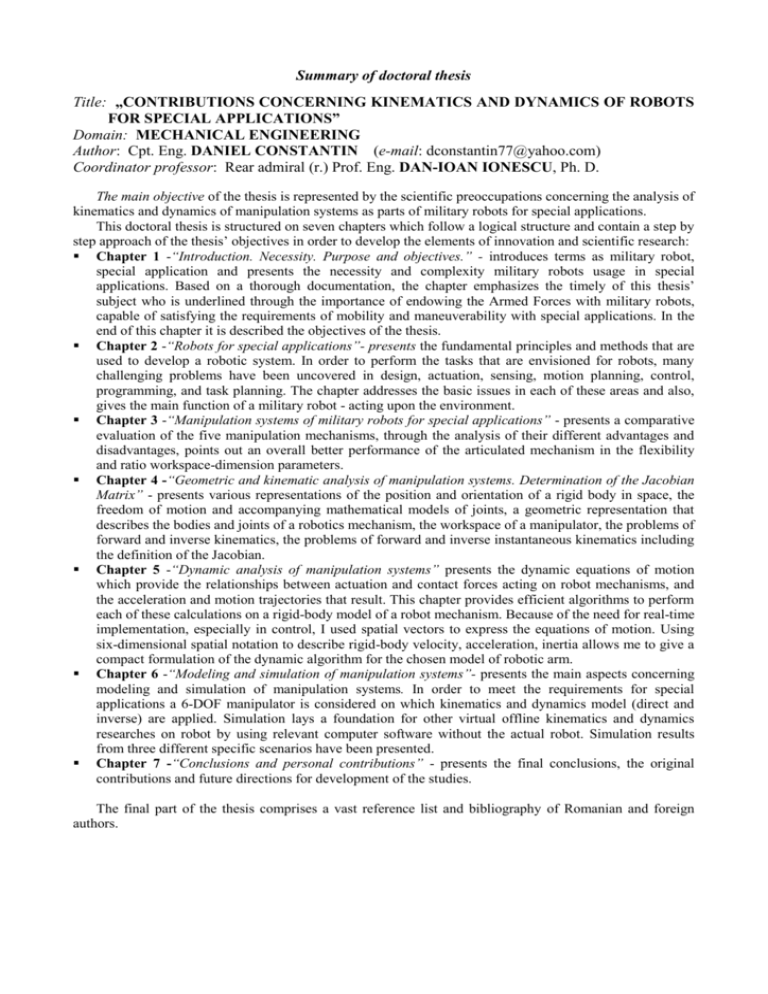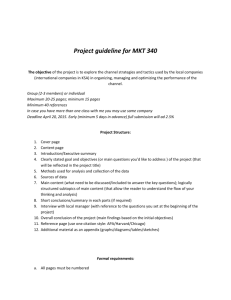Summary of doctoral thesis Title: „CONTRIBUTIONS CONCERNING
advertisement

Summary of doctoral thesis Title: „CONTRIBUTIONS CONCERNING KINEMATICS AND DYNAMICS OF ROBOTS FOR SPECIAL APPLICATIONS” Domain: MECHANICAL ENGINEERING Author: Cpt. Eng. DANIEL CONSTANTIN (e-mail: dconstantin77@yahoo.com) Coordinator professor: Rear admiral (r.) Prof. Eng. DAN-IOAN IONESCU, Ph. D. The main objective of the thesis is represented by the scientific preoccupations concerning the analysis of kinematics and dynamics of manipulation systems as parts of military robots for special applications. This doctoral thesis is structured on seven chapters which follow a logical structure and contain a step by step approach of the thesis’ objectives in order to develop the elements of innovation and scientific research: Chapter 1 -“Introduction. Necessity. Purpose and objectives.” - introduces terms as military robot, special application and presents the necessity and complexity military robots usage in special applications. Based on a thorough documentation, the chapter emphasizes the timely of this thesis’ subject who is underlined through the importance of endowing the Armed Forces with military robots, capable of satisfying the requirements of mobility and maneuverability with special applications. In the end of this chapter it is described the objectives of the thesis. Chapter 2 -“Robots for special applications”- presents the fundamental principles and methods that are used to develop a robotic system. In order to perform the tasks that are envisioned for robots, many challenging problems have been uncovered in design, actuation, sensing, motion planning, control, programming, and task planning. The chapter addresses the basic issues in each of these areas and also, gives the main function of a military robot - acting upon the environment. Chapter 3 -“Manipulation systems of military robots for special applications” - presents a comparative evaluation of the five manipulation mechanisms, through the analysis of their different advantages and disadvantages, points out an overall better performance of the articulated mechanism in the flexibility and ratio workspace-dimension parameters. Chapter 4 -“Geometric and kinematic analysis of manipulation systems. Determination of the Jacobian Matrix” - presents various representations of the position and orientation of a rigid body in space, the freedom of motion and accompanying mathematical models of joints, a geometric representation that describes the bodies and joints of a robotics mechanism, the workspace of a manipulator, the problems of forward and inverse kinematics, the problems of forward and inverse instantaneous kinematics including the definition of the Jacobian. Chapter 5 -“Dynamic analysis of manipulation systems” presents the dynamic equations of motion which provide the relationships between actuation and contact forces acting on robot mechanisms, and the acceleration and motion trajectories that result. This chapter provides efficient algorithms to perform each of these calculations on a rigid-body model of a robot mechanism. Because of the need for real-time implementation, especially in control, I used spatial vectors to express the equations of motion. Using six-dimensional spatial notation to describe rigid-body velocity, acceleration, inertia allows me to give a compact formulation of the dynamic algorithm for the chosen model of robotic arm. Chapter 6 -“Modeling and simulation of manipulation systems”- presents the main aspects concerning modeling and simulation of manipulation systems. In order to meet the requirements for special applications a 6-DOF manipulator is considered on which kinematics and dynamics model (direct and inverse) are applied. Simulation lays a foundation for other virtual offline kinematics and dynamics researches on robot by using relevant computer software without the actual robot. Simulation results from three different specific scenarios have been presented. Chapter 7 -“Conclusions and personal contributions” - presents the final conclusions, the original contributions and future directions for development of the studies. The final part of the thesis comprises a vast reference list and bibliography of Romanian and foreign authors.





